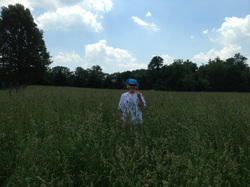 With loads of help from family and friends, we got the hay baled and under cover before the storms on Sunday evening. It all started with mowing on Wednesday and Thursday. The 4-foot high grass comes up to Fabian’s chin!
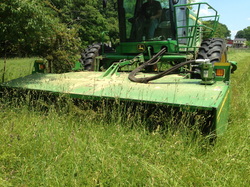 We used our haybine a month ago to take off a small first cutting, but this time we’re harvesting 60 acres. Most of it is for Ryan’s large square bales, but we made small bales from about 3 acres. Many thanks to Ryan for letting us use his discbine. His machine got the entire job done in about 7 hours--probably a quarter of the time ours would have taken.
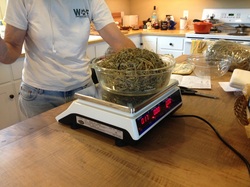 Next, a couple days of drying so the hay doesn’t rot after it’s baled and possibly start a fire in the barn. We calculated the moisture of the grass following the directions on the Penn State web site: extension.psu.edu/pubs/i-106
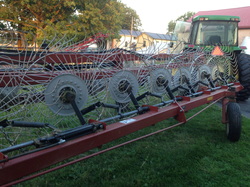 On Friday and Saturday, we used Ryan’s rake for his portion and our small rake for ours. On Sunday, the hay was down to 15-20% moisture--good to go. But storms were predicted for Sunday afternoon, so now the pressure was on to rake it one more time, get it baled and into the hay shed before the rain . Every time we bale hay, we have to race against time to beat the rain--it’s harder than you might think to have a five-day stretch of dry weather exactly when the hay is ready to be cut! We are definitely going to use a tedder for the next cutting so we can dry it quickly and get it done in a much shorter window of time--2 to 3 days instead of 5 or 6.
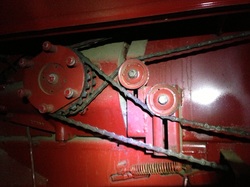 We crossed our fingers hoping there wouldn’t be major mechanical problems and got started around 11:00. The baler broke down due to a chain coming off its gear, but after Keith and Aaron figured out what happened, it was a pretty easy fix.
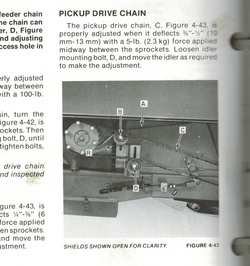 Above, you can see the top of the chain is routed under the idler, but the manual shows how the bottom loop of chain is supposed to go over the idler. Other than that, all systems were go and we had a successful day. And for the first time since we’ve had the New Holland 311, our bales were shaped correctly, with tight strings and well-formed flakes inside. Keith did lots of work over the past month to correct issues we’ve had with this baler since we got it: misshapen bales, sloppy strings incorrectly placed, and untied twine which caused loose grass instead of formed bales to spew out of the kicker. Each cutting left us with a mess that we couldn’t stack more than 3 or 4 rows high. There were lots of little missing and broken parts and bad adjustments throughout, but after three years of making hay, I think most of the wrinkles have been ironed out. Yeah!!!!! Here's a link to Aaron's video from the hay wagon as the bales get kicked out of the baler to him. When he's on-task (ie, not taking videos!), he never misses a bale.More pretty hay pictures:
 After reading about how our hens spend their days, some of you have asked, "What is a dust bath?"
Think of people you know who have the time and money (maybe you, if you're lucky!) to get a calming massage or soothing mud treatment. Our hens are like those people--kind of privileged compared to the general population. Virtually all hens in commercial egg production are confined in crowded facilities, where there is no accommodation for them to perform their natural grooming behaviors. But our lucky hens live right on the soil and can pamper themselves to their heart's content.
Let's be real--by human standards of hygiene, chickens are pretty disgusting creatures. Their environment is covered with chicken sh**, and it can smell pretty bad, even in open-air shelters. That's why we move them to a new patch of pasture every week or so. The benefit of this constant movement across our pastures is that the chickens leave their nitrogen-rich droppings behind, organically fertilizing our fields for us!
As soon as they're in a new area, they start scratching and pecking, creating bowl-shaped depressions in the soil for their dust baths. Working in groups, they critique each others' efforts.
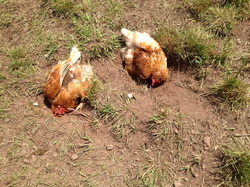 Once the hens are satisfied with their work, they wriggle around and flap their wings to disperse the loosened dirt between their feathers down to their skin. This grooming removes parasites and controls the buildup of oil that coats their plumage. Then they give a big shake to expel the excess dust, and go about their business pecking the ground for delicious snacks of bugs.
Because our hens live outdoors, they can maintain feather and skin health naturally, eliminating the need for chemical insecticides. And they seem to enjoy it, too!
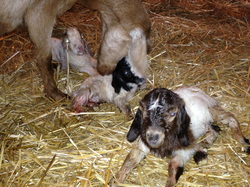 During evening chores on Monday Fabian was saying what a quiet day it was. Faith was helping me feed the baby goats when I heard someone yelling in the shed. I ran over and saw Noora lying on her side writhing and kicking. Honestly, if you've never heard a goat scream, it sounds hauntingly like a person. At first I thought she was injured, but then I saw a tiny baby goat in the corner and the bottoms of two hooves emerging from under Noora's tail. That's not what I want to see during kidding. With the proper presentation--a nose and the tops of two front hooves--the kids slip right out. This was a breech birth, so I crossed my fingers and pulled to see if the baby was stuck in the birth canal. Just one little tug, and it plunked down onto the ground. Whew! That was easy. As Noora got to work licking all the gunk off her new baby, the third kid, facing the right direction, emerged without much ado. The final tally: 2 boys and 1 girl ranging from 4 to over 9 pounds.
They're all cleaned up, getting settled into a clean kidding jug in the barn, and getting their first sips of colostrum. An exciting end to a quiet day!
Yesterday we had some farm hands here to help to set up a new paddock for the cows. I almost lost the short one in the hay field!
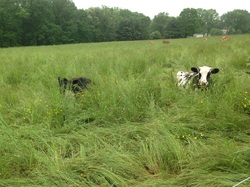 Then today I went out to water the cows, and I didn't see Bandito and Gwendolyn. I finally found them contentedly munching their cud in the cool tall grasses of their new paddock. I'm pretty sure they were smiling!
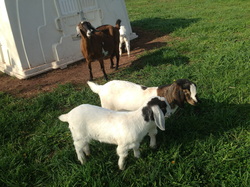 We've reached our goals this year in our goat breeding program. Our original does are Nubians, a dairy breed. In the first year, we bred them with a Boer, a meat breed. The daughters of this mating are the F-1 generation, and are half Nubian/half Boer. When the F-1 daughters are bred to a Boer buck, we get the F-2s, who are three-quarters Boer (for a meaty carcass) and one-quarter Nubian (for mild flavor and tenderness). In this picture you can compare the F-1 kid standing in front of the much bulkier F-2. Billy, our current buck, is very sweet and easy to manage, and he produced wonderful kids. Because we'll be breeding his daughters next year, we'll have to replace him with another buck.
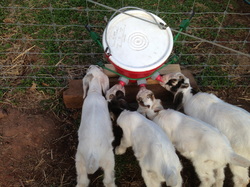 These adorable bottle babies are as friendly as can be. Since they're so well bonded to humans, they will make excellent pets. They're all dehorned and the males are wethered (castrated). Goats are natural browsers, gobbling up brambles, briers, poison ivy (their favorite treat!), wild grape, multiflora rose and all your other nuisance weeds. But they're also quite talented lawn mowers. In another few weeks, they'll be old enough to move on to their adoptive homes. I'm favoring placements with room for two or more, or where there is other livestock, because goats, like all herd animals, prefer to be part of a group.
In the past week five lambs have been born at Misty Knoll Farm! Below is our biggest, at 12.48 pounds!
|





















 RSS Feed
RSS Feed